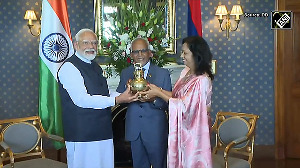The terror outfit carried out Wednesday’s attack following a directive from the Lashkar-e-Tayiba to possibly avenge the execution of Afzal Guru, according to the Intelligence Bureau. Vicky Nanjappa reports
A Lashkar-e-Tayiba directive to the Indian Mujahideen is what triggered off the twin blasts in Hyderabad on Wednesday, according to the Intelligence Bureau.
The Dilsukh Nagar area was surveyed in 2011, but the attack was put on hold as the terror outfit was looking for an opportune time, IB officials told rediff.com.
The bomber, according to sources, is one Manzhar, who has been residing in Hyderabad for the past five months. After the reccee was carried out, he is said to have stayed back in the city and oversaw the operation.
Manzhar stayed at a lodge under the alias of Amith, sources pointed out. He is alleged to have met with Indian Mujahideen’s Yasin Bhatkal in January to discuss the Hyderabad attack. Hyderabad has been on the radar of the IM and the Lashkar for a long time. The Lashkar in fact had openly said that it would like to “liberate Hyderabad and restore the rule of the nizam”.
Intelligence Bureau officials said that the directive to carry out the blasts was issued by the Lashkar. They probably wanted to time it with the execution of Parliament attack convict Afzal Guru. This in fact has led the Hyderabad police to question many members who had led protests against the Guru’s hanging. Initial leads suggest that avenging Guru’s execution could be the main motive behind the attacks. IM operatives in custody of the Delhi police had earlier confessed that they wanted to fight against the injustices in Kashmir.
Shishir Gupta, who has written a detailed book on the IM, said, “Modules of the IM have been created in Hyderabad over the past couple of years. Earlier, the city was under the control of the Harkat-ul-Jihad al-Islami led by Shahid Bilal, but after his death the IM modules controlled the terror activities. Even this attack was carried out by the IM on the directive of the Lashkar and was timed with the hanging of Afzal Guru.”






 © 2025
© 2025